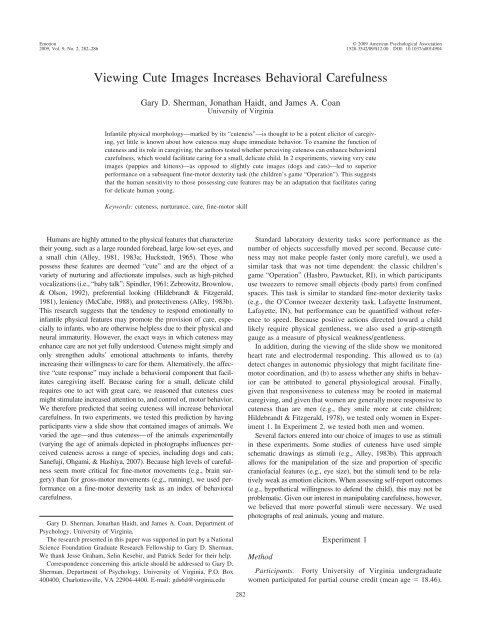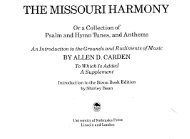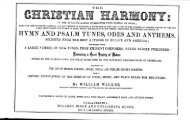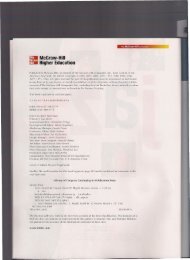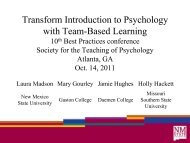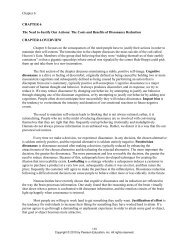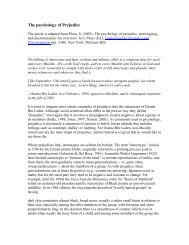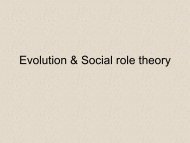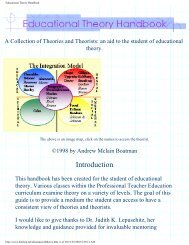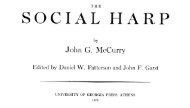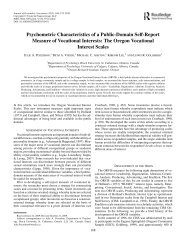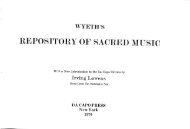Sherman Haidt Coan -- Cuteness and Carefulness
Sherman Haidt Coan -- Cuteness and Carefulness
Sherman Haidt Coan -- Cuteness and Carefulness
Create successful ePaper yourself
Turn your PDF publications into a flip-book with our unique Google optimized e-Paper software.
Emotion © 2009 American Psychological Association<br />
2009, Vol. 9, No. 2, 282–286 1528-3542/09/$12.00 DOI: 10.1037/a0014904<br />
Viewing Cute Images Increases Behavioral <strong>Carefulness</strong><br />
Gary D. <strong>Sherman</strong>, Jonathan <strong>Haidt</strong>, <strong>and</strong> James A. <strong>Coan</strong><br />
University of Virginia<br />
Infantile physical morphology—marked by its “cuteness”—is thought to be a potent elicitor of caregiving,<br />
yet little is known about how cuteness may shape immediate behavior. To examine the function of<br />
cuteness <strong>and</strong> its role in caregiving, the authors tested whether perceiving cuteness can enhance behavioral<br />
carefulness, which would facilitate caring for a small, delicate child. In 2 experiments, viewing very cute<br />
images (puppies <strong>and</strong> kittens)—as opposed to slightly cute images (dogs <strong>and</strong> cats)—led to superior<br />
performance on a subsequent fine-motor dexterity task (the children’s game “Operation”). This suggests<br />
that the human sensitivity to those possessing cute features may be an adaptation that facilitates caring<br />
for delicate human young.<br />
Keywords: cuteness, nurturance, care, fine-motor skill<br />
Humans are highly attuned to the physical features that characterize<br />
their young, such as a large rounded forehead, large low-set eyes, <strong>and</strong><br />
a small chin (Alley, 1981, 1983a; Huckstedt, 1965). Those who<br />
possess these features are deemed “cute” <strong>and</strong> are the object of a<br />
variety of nurturing <strong>and</strong> affectionate impulses, such as high-pitched<br />
vocalizations (i.e., “baby talk”; Spindler, 1961; Zebrowitz, Brownlow,<br />
& Olson, 1992), preferential looking (Hildebr<strong>and</strong>t & Fitzgerald,<br />
1981), leniency (McCabe, 1988), <strong>and</strong> protectiveness (Alley, 1983b).<br />
This research suggests that the tendency to respond emotionally to<br />
infantile physical features may promote the provision of care, especially<br />
to infants, who are otherwise helpless due to their physical <strong>and</strong><br />
neural immaturity. However, the exact ways in which cuteness may<br />
enhance care are not yet fully understood. <strong>Cuteness</strong> might simply <strong>and</strong><br />
only strengthen adults’ emotional attachments to infants, thereby<br />
increasing their willingness to care for them. Alternatively, the affective<br />
“cute response” may include a behavioral component that facilitates<br />
caregiving itself. Because caring for a small, delicate child<br />
requires one to act with great care, we reasoned that cuteness cues<br />
might stimulate increased attention to, <strong>and</strong> control of, motor behavior.<br />
We therefore predicted that seeing cuteness will increase behavioral<br />
carefulness. In two experiments, we tested this prediction by having<br />
participants view a slide show that contained images of animals. We<br />
varied the age—<strong>and</strong> thus cuteness—of the animals experimentally<br />
(varying the age of animals depicted in photographs influences perceived<br />
cuteness across a range of species, including dogs <strong>and</strong> cats;<br />
Sanefuji, Ohgami, & Hashiya, 2007). Because high levels of carefulness<br />
seem more critical for fine-motor movements (e.g., brain surgery)<br />
than for gross-motor movements (e.g., running), we used performance<br />
on a fine-motor dexterity task as an index of behavioral<br />
carefulness.<br />
Gary D. <strong>Sherman</strong>, Jonathan <strong>Haidt</strong>, <strong>and</strong> James A. <strong>Coan</strong>, Department of<br />
Psychology, University of Virginia.<br />
The research presented in this paper was supported in part by a National<br />
Science Foundation Graduate Research Fellowship to Gary D. <strong>Sherman</strong>.<br />
We thank Jesse Graham, Selin Kesebir, <strong>and</strong> Patrick Seder for their help.<br />
Correspondence concerning this article should be addressed to Gary D.<br />
<strong>Sherman</strong>, Department of Psychology, University of Virginia, P.O. Box<br />
400400, Charlottesville, VA 22904-4400. E-mail: gds6d@virginia.edu<br />
282<br />
St<strong>and</strong>ard laboratory dexterity tasks score performance as the<br />
number of objects successfully moved per second. Because cuteness<br />
may not make people faster (only more careful), we used a<br />
similar task that was not time dependent: the classic children’s<br />
game “Operation” (Hasbro, Pawtucket, RI), in which participants<br />
use tweezers to remove small objects (body parts) from confined<br />
spaces. This task is similar to st<strong>and</strong>ard fine-motor dexterity tasks<br />
(e.g., the O’Connor tweezer dexterity task, Lafayette Instrument,<br />
Lafayette, IN), but performance can be quantified without reference<br />
to speed. Because positive actions directed toward a child<br />
likely require physical gentleness, we also used a grip-strength<br />
gauge as a measure of physical weakness/gentleness.<br />
In addition, during the viewing of the slide show we monitored<br />
heart rate <strong>and</strong> electrodermal responding. This allowed us to (a)<br />
detect changes in autonomic physiology that might facilitate finemotor<br />
coordination, <strong>and</strong> (b) to assess whether any shifts in behavior<br />
can be attributed to general physiological arousal. Finally,<br />
given that responsiveness to cuteness may be rooted in maternal<br />
caregiving, <strong>and</strong> given that women are generally more responsive to<br />
cuteness than are men (e.g., they smile more at cute children;<br />
Hildebr<strong>and</strong>t & Fitzgerald, 1978), we tested only women in Experiment<br />
1. In Experiment 2, we tested both men <strong>and</strong> women.<br />
Several factors entered into our choice of images to use as stimuli<br />
in these experiments. Some studies of cuteness have used simple<br />
schematic drawings as stimuli (e.g., Alley, 1983b). This approach<br />
allows for the manipulation of the size <strong>and</strong> proportion of specific<br />
craniofacial features (e.g., eye size), but the stimuli tend to be relatively<br />
weak as emotion elicitors. When assessing self-report outcomes<br />
(e.g., hypothetical willingness to defend the child), this may not be<br />
problematic. Given our interest in manipulating carefulness, however,<br />
we believed that more powerful stimuli were necessary. We used<br />
photographs of real animals, young <strong>and</strong> mature.<br />
Experiment 1<br />
Method<br />
Participants. Forty University of Virginia undergraduate<br />
women participated for partial course credit (mean age 18.46).
Participants were r<strong>and</strong>omly assigned to one of two conditions (low<br />
cuteness or high cuteness).<br />
Stimuli. The slide show consisted of three sections, each with<br />
nine images. The first (baseline) <strong>and</strong> third (post) sections featured<br />
neutral images of house interiors <strong>and</strong> were identical in content<br />
across conditions. The middle (main) section featured images of<br />
animals—either puppies <strong>and</strong> kittens (high cuteness) or dogs <strong>and</strong><br />
cats (low cuteness), depending on condition. Each image was<br />
presented for 10 s, with a 3-s black screen providing a transition<br />
between images.<br />
We validated the main stimuli by having an independent sample<br />
(N 17) rate the images on cuteness <strong>and</strong> interestingness using<br />
6-point scales ranging from 0 (not at all) to5(extremely). Compared<br />
to the low-cuteness images, the high-cuteness images were<br />
considered cuter (M 3.98 vs. M 1.37), t(16) 15.21, p <br />
.001, <strong>and</strong> more interesting (M 2.44 vs. M 1.77), t(16) 3.35,<br />
p .01.<br />
Measures. A Biopac MP100 System (Biopac Systems, Goleta,<br />
CA), sampling at 1,000 Hz, was used for physiological data<br />
acquisition. An electrocardiogram (ECG) measured heart activity<br />
via three general purpose electrodes attached to each participant<br />
(Lead 1 configuration). Acqknowledge 3.7.2 software (Biopac<br />
Systems, Goleta, CA) extracted interbeat intervals (IBIs), which<br />
were then visually inspected <strong>and</strong> manually corrected for artifacts. An<br />
absolute measurement of skin conductance level (SCL) was obtained<br />
by placing two electrodes on the volar surface of the medial phalanges<br />
of the first <strong>and</strong> third fingers of the nondominant h<strong>and</strong>. We used Redux<br />
Electrolyte Paste (Parker Laboratories, Fairfield, NJ) as a conductant.<br />
To compute the change in heart rate (HR) <strong>and</strong> SCL from baseline to<br />
the main section, we computed mean HR <strong>and</strong> SCL levels for these<br />
sections using CMet Software (for HR; Allen, 2002; available from<br />
http://apsychoserver.psych.arizona.edu) <strong>and</strong> Acqknowledge 3.7.2<br />
software (for SCL).<br />
A slide show after the questionnaire assessed emotional impact<br />
(“How much did this slide show affect you emotionally?”), physical<br />
impact (“How much did this slide show affect you physically?”),<br />
<strong>and</strong> peak intensity of specific emotions (happiness, entertainment,<br />
amusement, calmness, tenderness, sadness, fear, <strong>and</strong><br />
surprise) on a 6-point scale ranging from 0 (not at all) to 5<br />
(extremely). At the end of the experiment, participants used the<br />
same 6-point scale to rate the cuteness <strong>and</strong> interestingness of the<br />
animal slide show. In addition, mood was assessed at the beginning<br />
of the experiment <strong>and</strong> after the slide show using a 100-point<br />
scale ranging from 1 (the worst I have ever felt), to 100 (the best<br />
I have ever felt).<br />
In the operation task, the participant used a pair of tweezers to<br />
remove various small plastic body parts from the “patient” without<br />
touching the tweezers to the sides of each compartment. Participants<br />
had one chance to remove each of 12 body parts, <strong>and</strong><br />
performance was scored as the number of body parts successfully<br />
removed. Finally, grip strength was measured using a h<strong>and</strong> dynamometer.<br />
Procedure. The experimenter told participants (who were run<br />
individually) that their physiology would be monitored while they<br />
performed several tasks. After a partial hookup was complete<br />
(ECG was not attached yet to keep participants’ dominant h<strong>and</strong><br />
free for the behavioral tasks), participants were given the h<strong>and</strong><br />
dynamometer <strong>and</strong> asked to squeeze it as hard as possible. Participants<br />
then played the Operation game while the experimenter<br />
BRIEF REPORTS<br />
observed unobtrusively <strong>and</strong> recorded their scores. Next, the ECG<br />
was attached <strong>and</strong> participants moved to the viewing chamber (a<br />
separate area of the experiment room, enclosed by a curtain), were<br />
seated, <strong>and</strong> watched the slide show on a projection screen. Afterward,<br />
the ECG was removed. Participants then squeezed the h<strong>and</strong><br />
dynamometer again, completed the questionnaire, <strong>and</strong> then played<br />
the Operation game once again. Participants then answered the<br />
final two self-report items.<br />
Results <strong>and</strong> Discussion<br />
The means for all self-report variables are presented in Table 1,<br />
along with the results of t tests of the difference in the mean for<br />
each item as a function of condition. The most intensely experienced<br />
emotions—happiness, calmness, tenderness, amusement,<br />
<strong>and</strong> entertainment—were experienced more intensely in the highcuteness<br />
condition than in the low-cuteness condition ( ps .05<br />
for all except calmness, for which p .10) <strong>and</strong> the high-cuteness<br />
slide show was rated as more interesting <strong>and</strong> cuter than the<br />
low-cuteness slide show ( ps .05).<br />
The mean change for each behavioral <strong>and</strong> physiological variable<br />
as a function of condition is presented in Table 2. As predicted,<br />
cuteness increased performance on a subsequent task requiring<br />
extreme carefulness: participants showed significantly greater improvement<br />
in performance (from before to after the slide show) on<br />
the operation task in the high-cuteness condition than in the<br />
low-cuteness condition, t(38) 1.99, p .05, d 0.63. Contrary<br />
to predictions, the manipulation of cuteness did not influence<br />
change in grip strength (t 1). HR did increase more in the<br />
high-cuteness condition (M 1.64) than in the low-cuteness<br />
condition (M .02), t(37) 1.89, p .07, d 0.61, but no effect<br />
of cuteness on change in SCL was observed (t 1).<br />
Because the stimuli used in the two conditions differed on a<br />
variety of dimensions beyond cuteness (e.g., interestingness, positivity),<br />
we examined the correlations between change in operation<br />
performance <strong>and</strong> the self-report variables. Change in performance<br />
was positively correlated with ratings of cuteness (r .29, p <br />
.07) <strong>and</strong> self-reported intensity of tenderness (r .34, p .05) but<br />
not with ratings of interest (r .09, p .60) or intensity of<br />
happiness, amusement, entertainment, calmness, sadness, or surprise<br />
(rs between .07 <strong>and</strong> .16, ps .33). This pattern suggests<br />
that the effect of cuteness on participants’ carefulness in executing<br />
fine-motor movements was likely due to the images’ cuteness <strong>and</strong><br />
tenderness-inducing qualities rather than their general positivity or<br />
interestingness.<br />
Experiment 2<br />
283<br />
In Experiment 1, viewing images of puppies <strong>and</strong> kittens enhanced<br />
fine-motor performance, supporting the hypothesis that<br />
cuteness increases behavioral carefulness. Although the pattern of<br />
correlations suggests that cuteness was the critical dimension<br />
responsible for this effect, the images differed on several dimensions,<br />
precluding us from ruling out other extraneous influences<br />
(e.g., positive affect). In Experiment 2, we aimed to replicate the<br />
main finding of Experiment 1 (that cuteness increased carefulness)<br />
with two entirely new sets of stimuli that were pretested to match<br />
across conditions in the levels of positive affect <strong>and</strong> interest they<br />
evoked. This matching allows us to isolate the effect of cuteness
284<br />
from these factors that may alter fine-motor performance independently.<br />
We also included male participants to test whether the<br />
effect of cuteness on carefulness was specific to women.<br />
Method<br />
Table 1<br />
Means (SE) for Self-Report Items by Experiment <strong>and</strong> Condition<br />
Participants. Fifty-six University of Virginia undergraduates<br />
participated for partial course credit (23 women, 33 men; mean<br />
age 18.80). We tested for, <strong>and</strong> report, any main or interactive<br />
effects of gender.<br />
Stimuli. Because the two sets of stimuli used in Experiment 1<br />
differed on more dimensions than cuteness, we created a new<br />
low-cuteness image set that included more interesting dog images<br />
as well as several images of lions <strong>and</strong> tigers. Although this exp<strong>and</strong>s<br />
the range of animals to include more exotic felines (that are rarely<br />
kept as pets), this was necessary to achieve a level of interest,<br />
emotional power, <strong>and</strong> positivity similar to that of the puppy <strong>and</strong><br />
kitten images. In addition, to enhance the generalizability of any<br />
BRIEF REPORTS<br />
Experiment 1 Experiment 2<br />
Variable Low cute High cute p Low cute High cute p<br />
General<br />
Emotional impact 1.35 (.21) 2.40 (.23) .002 2.14 (.27) 1.54 (.23) .09<br />
Physical impact .40 (.15) .65 (.21) .34 .93 (.24) 1.00 (.19) .81<br />
Change in mood .79 (2.21) 6.29 (1.88) .02 4.12 (1.49) 2.54 (1.63) .48<br />
Emotion<br />
Happiness 1.75 (.34) 3.60 (.27) .001 2.82 (.28) 2.71 (.30) .79<br />
Calmness 2.45 (.36) 3.40 (.37) .07 3.00 (.33) 3.57 (.24) .17<br />
Tenderness 1.30 (.31) 2.55 (.39) .02 2.04 (.29) 2.54 (.30) .23<br />
Amusement .85 (.21) 2.30 (.31) .001 2.14 (.29) 2.29 (.31) .74<br />
Entertainment .60 (.21) 1.90 (.36) .003 1.39 (.24) 1.29 (.27) .77<br />
Surprise .60 (.22) .60 (.27) 1.00 .75 (.19) .43 (.17) .22<br />
Sadness .50 (.19) .55 (.27) .88 .50 (.19) .43 (.14) .76<br />
Fear .20 (.12) .10 (.10) .52 .46 (.16) .21 (.12) .21<br />
Ratings<br />
Interesting 1.75 (.25) 2.60 (.31) .04 2.57 (.27) 2.50 (.27) .85<br />
Cute 3.15 (.27) 4.75 (.10) .001 3.07 (.31) 4.29 (.20) .002<br />
Note. Ratings were given on 6-point scale, ranging from 0 (not at all) to5(extremely). p result of t test of<br />
difference in means between conditions.<br />
findings, we used a new set of puppy <strong>and</strong> kitten images. An<br />
independent sample (N 12) assessed the following dimensions:<br />
cute, interesting, enjoyable, <strong>and</strong> exciting using 6-point scales ranging<br />
from 0 (not at all) to5(extremely). Compared to the lowcuteness<br />
images, the high-cuteness images were rated as being<br />
cuter (M 4.43 vs. M 2.86), t(16) 9.23, p .001. The two<br />
sets of images, however, were equally interesting (M 3.37 vs.<br />
M 3.50), equally enjoyable (M 3.67 vs. M 3.40), <strong>and</strong><br />
equally exciting (M 1.55 vs. M 1.89) (all ts 1.63,ps .12).<br />
Measures <strong>and</strong> Procedure. The measures <strong>and</strong> procedure of<br />
Experiment 2 were identical to those of Experiment 1, except for<br />
one minor change: after the slide show, completion of the questionnaire<br />
followed playing the Operation game. This change was<br />
made to rule out the possibility that the effect of cuteness on carefulness<br />
in Experiment 1 was due to the secondary act of reflecting on,<br />
<strong>and</strong> writing about, one’s emotional experience (of tenderness <strong>and</strong><br />
other emotions) rather than the primary act of viewing the images.<br />
Table 2<br />
Mean Difference Scores (SE) for Physiological <strong>and</strong> Behavioral Variables by Experiment<br />
<strong>and</strong> Condition<br />
Experiment 1 Experiment 2<br />
Variable Low cute High cute p Low cute High cute p<br />
Change in:<br />
Operation .60 (.44) 1.80 (.41) .05 .46 (.29) 1.32 (.33) .05<br />
Grip strength 3.35 (1.56) 4.35 (2.33) .72 1.93 (1.31) 2.43 (1.16) .78<br />
HR .02 (.46) 1.64 (.72) .07 .73 (.35) 1.17 † (.63) .54<br />
SCL .79 (.15) .67 (.21) .64 .76 (.18) .59 (.15) .48<br />
Note. Operation measured in body parts (maximum 12). Grip strength was measured in pounds per square<br />
inch. Heart rate (HR) was measured in beats per minute. Skin conductance level (SCL) was measured in<br />
micromhos. p significance level for test of whether difference scores varied by condition (independent-<br />
samples t test). Difference scores marked with a symbol differed significantly from zero (one-sample t test).<br />
†<br />
p .05. p .10.
Having participants wait to report on their emotional experience<br />
until after the fine-motor dexterity task allowed our carefulness<br />
measure to immediately follow the viewing of the images.<br />
Results <strong>and</strong> Discussion<br />
The means for all self-report variables are presented in Table 1,<br />
along with the results of t tests of the difference in the mean for<br />
each item as a function of condition. The two sets of stimuli used<br />
were nearly identical except for the critical dimension of cuteness.<br />
Notably, the two conditions did not differ on change in mood or on<br />
any specific emotion. This was true even of tenderness—an emotion<br />
putatively related to cuteness—although the difference between<br />
the means was in the predicted direction. 1 This means that<br />
the two slide shows were matched on the degree to which they<br />
elicited positive affect. Therefore, our cuteness manipulation was<br />
effective in isolating the specific effect of cuteness from the more<br />
general potential influences of positive emotion or mood. In addition,<br />
it is noteworthy that our inclusion of several lion <strong>and</strong> tiger<br />
images as low-cuteness stimuli did not amplify any negative<br />
emotions. For example, the self-reported intensity of fear did not<br />
differ by condition <strong>and</strong> was extremely low in both conditions.<br />
The mean change of each behavioral <strong>and</strong> physiological variable<br />
as a function of condition is presented in Table 2. Replicating the<br />
main finding of Experiment 1, participants showed significantly<br />
greater improvement on the operation task in the high-cuteness<br />
condition than in the low-cuteness condition, t(54) 1.97, p <br />
.05, d 0.48. Although there was a trend for women (d 1.03)<br />
to show a larger effect of condition than men (d 0.24), this was<br />
not statistically significant: Gender Condition interaction, F(1,<br />
52) 1.36, p .25. As in Experiment 1, cuteness did not affect<br />
change in grip strength (t 1). Unlike in Experiment 1, in which<br />
cuteness was associated with increased HR, neither change in HR<br />
nor change in SCL differed by condition (ts 1). Together, this<br />
pattern makes it unlikely that the observed effect of cuteness on<br />
operation performance was due to general physiological arousal.<br />
Although change in HR did not differ by condition, it increased<br />
slightly in both conditions, perhaps because viewing pictures of<br />
animals (whether high or low in cuteness) triggers excitement <strong>and</strong><br />
an approach orientation.<br />
Unlike in Experiment 1, change in operation performance was<br />
not significantly related to any self-report items (rs between .13<br />
<strong>and</strong> .19, ps .15). The failure to replicate the relationship between<br />
self-reported tenderness <strong>and</strong> behavioral carefulness found in Experiment<br />
1 may have been due to the longer delay in Experiment<br />
2 between the slide show <strong>and</strong> completion of the questionnaire. The<br />
further self-report emotional assessments get from the event in<br />
question, the more people’s responses tend to reflect their beliefs<br />
about emotion rather than emotion itself (Robinson & Clore,<br />
2002a, 2002b). Thus, self-reports of tenderness in Experiment 2<br />
may have been less indicative of the intensity of experienced<br />
tenderness than those obtained in Experiment 1.<br />
General Discussion<br />
In two experiments, we found that exposure to images of young,<br />
cute animals (kittens <strong>and</strong> puppies) increased performance on a task<br />
that dem<strong>and</strong>ed extreme carefulness in order to successfully execute<br />
finely tuned motor movements (the children’s game Opera-<br />
BRIEF REPORTS<br />
tion), an effect that cannot be attributed to general positivity (e.g.,<br />
mood or specific positive emotion) or arousal (measured via selfreport<br />
<strong>and</strong> autonomic physiology). This behavioral shift toward<br />
increased carefulness makes sense as an adaptation for caring for<br />
small children, <strong>and</strong> is consistent with the view that cuteness is a<br />
releaser of the human caregiving system (Lorenz, 1950/1971).<br />
Moreover, this finding suggests that cuteness does not just influence<br />
one’s willingness to engage in caregiving behaviors but also<br />
influences the ability of one to do so. That is, cuteness not only<br />
compels us to care for cute things but also prepares us to do so via<br />
its effects on behavioral carefulness.<br />
This finding fits nicely with the embodied cognition perspective<br />
that emphasizes the way affective states are constrained by, <strong>and</strong><br />
expressed in, the body (Barrett & Lindquist, 2008). Our finding<br />
suggests that the tenderness elicited by something “cute” is more<br />
than just a positive affective feeling state—it can literally make<br />
people more physically tender in their motor behavior. Research<br />
has demonstrated an ideomotor effect whereby the processing of<br />
positive stimuli facilitates pulling a lever, the basic motor behavior<br />
involved in pulling desired objects closer (presumably reflecting a<br />
behavioral predisposition for approach; Chen & Bargh, 1999;<br />
Rotteveel & Phaf, 2004). The current finding may be a novel<br />
manifestation of the extension of this effect beyond simple valence-approach/avoid<br />
relationships. Having a specific kind of positive<br />
affective orientation toward an object (finding it cute <strong>and</strong><br />
experiencing tender feelings) can influence the specific kind of<br />
motor actions one is prepared to make (careful, tender movements).<br />
Contrary to predictions, cuteness did not make people any<br />
weaker, at least as we measured it. It is possible that had we not<br />
instructed participants to squeeze as hard as possible (which may<br />
have amplified variance associated with trait strength <strong>and</strong> limited<br />
variance associated with state strength), that cuteness would have<br />
had a noticeable effect. That is, cuteness may not make people<br />
physically weaker but may make them less willing to exert their<br />
full strength. Another concern is that grip strength is often used as<br />
a measure of motivation. If cuteness triggered an approachoriented<br />
motivational state this may have counteracted any shift<br />
toward gentleness.<br />
This is the first investigation to document that immediate shifts<br />
in carefulness—indexed here by fine-motor performance—can be<br />
elicited by cuteness cues. This suggests that two factors—the<br />
importance of physical contact in early mammalian development<br />
<strong>and</strong> the extremely delicate nature of human young—may have<br />
exerted evolutionary pressures favoring those who could respond<br />
to the presence of cues colloquially described as “cute” with<br />
increased carefulness.<br />
1 Women reported more tenderness <strong>and</strong> sadness <strong>and</strong> rated the images as<br />
cuter <strong>and</strong> more interesting, regardless of condition, than did men.<br />
References<br />
285<br />
Allen, J. J. B. (2002). Calculating metrics of cardiac chronotropy: A<br />
pragmatic overview. Psychophysiology, 39, S18.<br />
Alley, T. R. (1981). Head shape <strong>and</strong> the perception of cuteness. Developmental<br />
Psychology, 17, 650–654.<br />
Alley, T. R. (1983a). Age-related changes in body proportions, body size,<br />
<strong>and</strong> perceived cuteness. Perceptual <strong>and</strong> Motor Skills, 56, 615–622.
286<br />
Alley, T. R. (1983b). Infantile head shape as an elicitor of adult protection.<br />
Merrill-Palmer Quarterly, 29, 411–427.<br />
Barrett, L. F., & Lindquist, K. A. (2008). The embodiment of emotion. In<br />
G. R. Semin & E. R. Smith (Eds.), Embodied grounding: Social,<br />
cognitive, affective, <strong>and</strong> neuroscientific approaches (pp. 237–262). New<br />
York: Cambridge University Press.<br />
Chen, M., & Bargh, J. A. (1999). Consequences of automatic evaluation:<br />
Immediate behavioral predispositions to approach or avoid the stimulus.<br />
Personality <strong>and</strong> Social Psychology Bulletin, 25, 215–224.<br />
Hildebr<strong>and</strong>t, K. A., & Fitzgerald, H. E. (1978). Adults’ responses to infants<br />
varying in perceived cuteness. Behavioural Processes, 3, 159–172.<br />
Hildebr<strong>and</strong>t, K. A., & Fitzgerald, H. E. (1981). Mothers’ responses to<br />
infant physical appearance. Infant Mental Health Journal, 2, 56–64.<br />
Huckstedt, B. (1965). Experimentelle untersuchungen zum “kindchenschema.”<br />
[Experimental studies on the “baby schema”]. Zeitschrift fur<br />
Experimentelle und Angew<strong>and</strong>te Psychologie, 12, 421–450.<br />
Lorenz, K. (1971). Studies in animal <strong>and</strong> human behaviour, Vol. 2.<br />
(R. Martin, Trans.). Cambridge, MA: Harvard University Press. (Original<br />
work published 1950).<br />
McCabe, V. (1988). Facial proportions, perceived age, <strong>and</strong> caregiving. In<br />
T. R. Alley (Ed.), Social <strong>and</strong> applied aspects of perceiving faces (pp.<br />
89–95). Hillsdale, NJ: Erlbaum.<br />
BRIEF REPORTS<br />
E-Mail Notification of Your Latest Issue Online!<br />
Robinson, M. D., & Clore, G. L. (2002a). Belief <strong>and</strong> feeling: Evidence for<br />
an accessibility model of emotional self-report. Psychological Bulletin,<br />
128, 934–960.<br />
Robinson, M. D., & Clore, G. L. (2002b). Episodic <strong>and</strong> semantic knowledge<br />
in emotional self-report: Evidence for two judgment processes.<br />
Journal of Personality <strong>and</strong> Social Psychology, 83, 198–215.<br />
Rotteveel, M., & Phaf, R. H. (2004). Automatic affective evaluation does<br />
not automatically predispose for arm flexion <strong>and</strong> extension. Emotion, 4,<br />
156–172.<br />
Sanefuji, W., Ohgami, H., & Hashiya, K. (2007). Development of preference<br />
for baby faces across species in humans (Homo sapiens). Journal<br />
of Ethology, 25, 249–254.<br />
Spindler, P. (1961). Studien zur vererbung von verhaltensweisen. 3. Verhalten<br />
gegenuber jungen katzen. [Studies on the transmission of behavioral<br />
patterns. 3. Behavior toward young cats]. Anthropologischer Anzeiger,<br />
25, 60–80.<br />
Zebrowitz, L. A., Brownlow, S., & Olson, K. (1992). Baby talk to the<br />
babyfaced. Journal of Nonverbal Behavior, 16, 143–158.<br />
Received July 17, 2008<br />
Revision received October 31, 2008<br />
Accepted November 10, 2008 <br />
Would you like to know when the next issue of your favorite APA journal will be available<br />
online? This service is now available to you. Sign up at http://notify.apa.org/ <strong>and</strong> you will be<br />
notified by e-mail when issues of interest to you become available!


